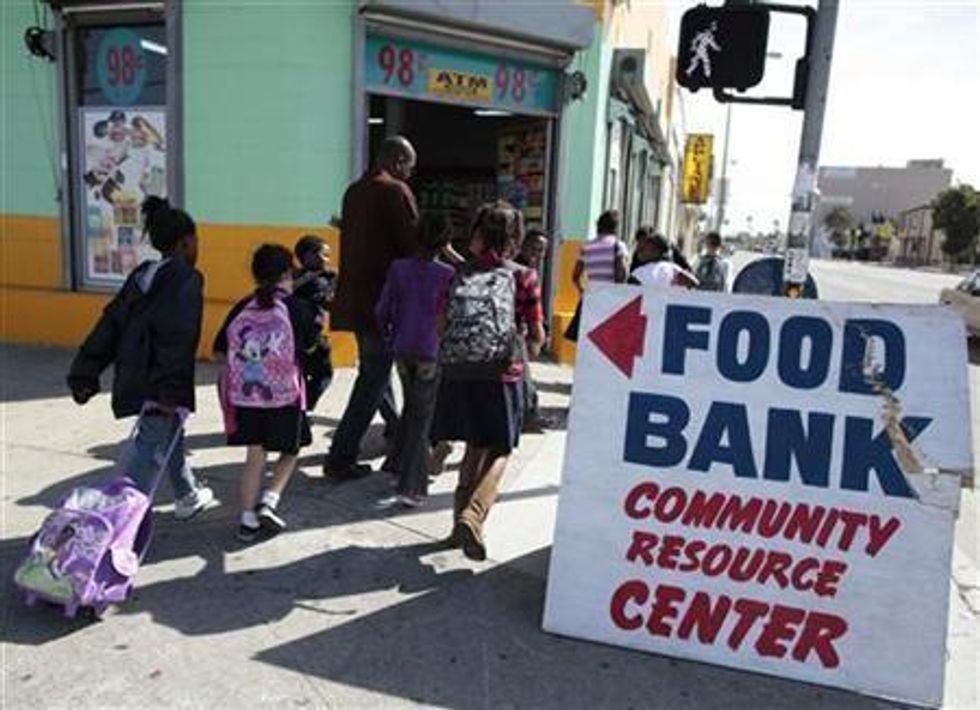Nearly Half of Americans Living Paycheck to Paycheck
Report finds 44 percent of people in U.S. have less than three months' worth of savings, leaving them one emergency away from disaster

So finds the 2014 Assets and Opportunities Scorecard released Thursday by the Corporation for Enterprise Development. According to the report, 44 percent of people in the United States live in "liquid asset poverty," which means they own less than three months' worth of savings ($5,887 for a family of four).
Without a safety net, a liquid asset poor family must borrow to deal with unforeseen financial emergencies. "For the 56% of consumers who have sub-prime credit scores, the only option may be to take out a high-cost--often predatory--loan, which can create a cycle of debt and worsen financial insecurity," the report notes.
People with low incomes and people of color are disproportionately liquid asset poor, with two of every three households of color and four out of five of the lowest-income households (making less than $18,193) falling into this category, according to the report. Furthermore, liquid asset poverty hits the U.S. south the hardest, the study finds.
Yet the problem, which the study says is stuck at high levels, does not spare the so-called middle class. A quarter of all middle class homes have less than three months of savings.
Yet, previous research suggests the CFED report might be an under-count. A survey this summer by Bankrate.com found that less than one in four Americans has enough money saved to cover six months' worth of expenses.
_____________________
An Urgent Message From Our Co-Founder
Dear Common Dreams reader, The U.S. is on a fast track to authoritarianism like nothing I've ever seen. Meanwhile, corporate news outlets are utterly capitulating to Trump, twisting their coverage to avoid drawing his ire while lining up to stuff cash in his pockets. That's why I believe that Common Dreams is doing the best and most consequential reporting that we've ever done. Our small but mighty team is a progressive reporting powerhouse, covering the news every day that the corporate media never will. Our mission has always been simple: To inform. To inspire. And to ignite change for the common good. Now here's the key piece that I want all our readers to understand: None of this would be possible without your financial support. That's not just some fundraising cliche. It's the absolute and literal truth. We don't accept corporate advertising and never will. We don't have a paywall because we don't think people should be blocked from critical news based on their ability to pay. Everything we do is funded by the donations of readers like you. Will you donate now to help power the nonprofit, independent reporting of Common Dreams? Thank you for being a vital member of our community. Together, we can keep independent journalism alive when it’s needed most. - Craig Brown, Co-founder |

So finds the 2014 Assets and Opportunities Scorecard released Thursday by the Corporation for Enterprise Development. According to the report, 44 percent of people in the United States live in "liquid asset poverty," which means they own less than three months' worth of savings ($5,887 for a family of four).
Without a safety net, a liquid asset poor family must borrow to deal with unforeseen financial emergencies. "For the 56% of consumers who have sub-prime credit scores, the only option may be to take out a high-cost--often predatory--loan, which can create a cycle of debt and worsen financial insecurity," the report notes.
People with low incomes and people of color are disproportionately liquid asset poor, with two of every three households of color and four out of five of the lowest-income households (making less than $18,193) falling into this category, according to the report. Furthermore, liquid asset poverty hits the U.S. south the hardest, the study finds.
Yet the problem, which the study says is stuck at high levels, does not spare the so-called middle class. A quarter of all middle class homes have less than three months of savings.
Yet, previous research suggests the CFED report might be an under-count. A survey this summer by Bankrate.com found that less than one in four Americans has enough money saved to cover six months' worth of expenses.
_____________________

So finds the 2014 Assets and Opportunities Scorecard released Thursday by the Corporation for Enterprise Development. According to the report, 44 percent of people in the United States live in "liquid asset poverty," which means they own less than three months' worth of savings ($5,887 for a family of four).
Without a safety net, a liquid asset poor family must borrow to deal with unforeseen financial emergencies. "For the 56% of consumers who have sub-prime credit scores, the only option may be to take out a high-cost--often predatory--loan, which can create a cycle of debt and worsen financial insecurity," the report notes.
People with low incomes and people of color are disproportionately liquid asset poor, with two of every three households of color and four out of five of the lowest-income households (making less than $18,193) falling into this category, according to the report. Furthermore, liquid asset poverty hits the U.S. south the hardest, the study finds.
Yet the problem, which the study says is stuck at high levels, does not spare the so-called middle class. A quarter of all middle class homes have less than three months of savings.
Yet, previous research suggests the CFED report might be an under-count. A survey this summer by Bankrate.com found that less than one in four Americans has enough money saved to cover six months' worth of expenses.
_____________________

